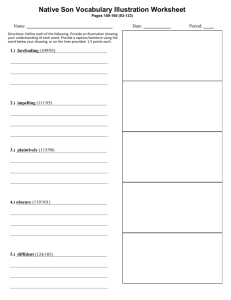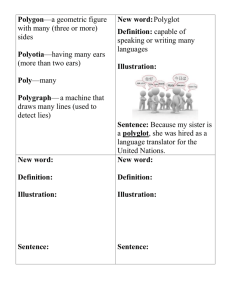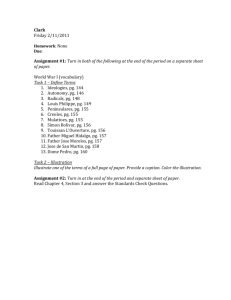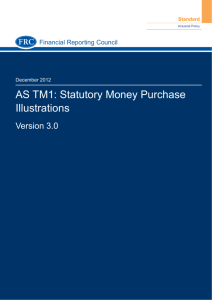Patterns of Organization: Tutor Hints for Reading Comprehension
advertisement
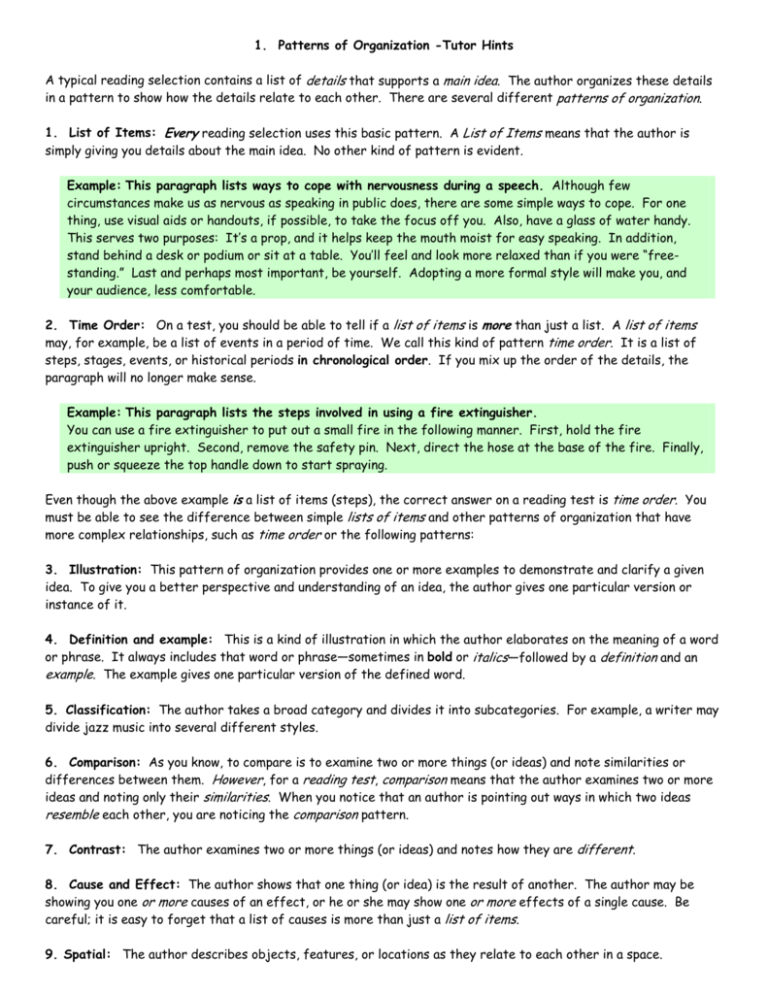
1. Patterns of Organization -Tutor Hints A typical reading selection contains a list of details that supports a main idea. The author organizes these details in a pattern to show how the details relate to each other. There are several different patterns of organization. 1. List of Items: Every reading selection uses this basic pattern. A List of Items means that the author is simply giving you details about the main idea. No other kind of pattern is evident. Example: This paragraph lists ways to cope with nervousness during a speech. Although few circumstances make us as nervous as speaking in public does, there are some simple ways to cope. For one thing, use visual aids or handouts, if possible, to take the focus off you. Also, have a glass of water handy. This serves two purposes: It’s a prop, and it helps keep the mouth moist for easy speaking. In addition, stand behind a desk or podium or sit at a table. You’ll feel and look more relaxed than if you were “freestanding.” Last and perhaps most important, be yourself. Adopting a more formal style will make you, and your audience, less comfortable. 2. Time Order: On a test, you should be able to tell if a list of items is more than just a list. A list of items may, for example, be a list of events in a period of time. We call this kind of pattern time order. It is a list of steps, stages, events, or historical periods in chronological order. If you mix up the order of the details, the paragraph will no longer make sense. Example: This paragraph lists the steps involved in using a fire extinguisher. You can use a fire extinguisher to put out a small fire in the following manner. First, hold the fire extinguisher upright. Second, remove the safety pin. Next, direct the hose at the base of the fire. Finally, push or squeeze the top handle down to start spraying. Even though the above example is a list of items (steps), the correct answer on a reading test is time order. You must be able to see the difference between simple lists of items and other patterns of organization that have more complex relationships, such as time order or the following patterns: 3. Illustration: This pattern of organization provides one or more examples to demonstrate and clarify a given idea. To give you a better perspective and understanding of an idea, the author gives one particular version or instance of it. 4. Definition and example: This is a kind of illustration in which the author elaborates on the meaning of a word or phrase. It always includes that word or phrase—sometimes in bold or italics—followed by a definition and an example. The example gives one particular version of the defined word. 5. Classification: The author takes a broad category and divides it into subcategories. For example, a writer may divide jazz music into several different styles. 6. Comparison: As you know, to compare is to examine two or more things (or ideas) and note similarities or differences between them. However, for a reading test, comparison means that the author examines two or more ideas and noting only their similarities. When you notice that an author is pointing out ways in which two ideas resemble each other, you are noticing the comparison pattern. 7. Contrast: The author examines two or more things (or ideas) and notes how they are different. 8. Cause and Effect: The author shows that one thing (or idea) is the result of another. The author may be showing you one or more causes of an effect, or he or she may show one or more effects of a single cause. Be careful; it is easy to forget that a list of causes is more than just a list of items. 9. Spatial: The author describes objects, features, or locations as they relate to each other in a space. Section 1: Read each passage and determine the overall pattern of organization the author is using. 1. Chimps are intelligent enough to make and use dinner utensils. Jane Goodall was the first scientist to study this behavior. One day, as she was observing, several chimps plucked long blades of grass and stripped off the leaves. Each licked one end to make it sticky, and poked the stem into a termite nest. Each chimp then pulled the stem out covered with termites and licked them off, much as a child would a lollipop. 2. There were two kinds of fireworks at the show last night. The first was the skyrocketing type, exploding high up in the air and producing the most dramatic effects, as well as “oohs” and “ahs” in the audience. The second type, Roman Candles, shot up separate showers of sparks and colored flames. 3. Winston, my friend’s old dog, doesn’t see well anymore. In the evening, when the light is dim, he bumps into chairs and walls as he searches for his bowl. 4. Open communication leads to healthier relationships. Research has shown that couples who often disclose their feelings to each other report having stronger feelings of love and happiness than others. Section 2: The following selections are main ideas taken from different paragraphs in a college textbook. Which pattern of organization does each one most likely suggest? 1. Parents tend to treat the oldest child differently from his or her siblings. 2. Artificial intelligence (AI) is a term that describes computer programs that solve problems by “thinking” the way people do. 3. The high cost of college today creates several problems for many students in more ways than one. 4. Identical twins, even when raised separately, have remarkably similar mannerisms. 5. The bartender keeps a gun under his cash register, and next to that, a can of Mace. 6. Certain colors are associated with particular emotions, as in the following examples. 7. There are a number of symptoms of drug abuse. 8. King Ludwig’s castle had several well-placed towers from which archers could fire on an attacking army. 9. There are three reasons why Titanic sank. 10. The following is a description of the North Shore Music Theater, from the entrance hall to backstage. 11. Her behavior was unusual yesterday in a number of ways. 12. Usury is the practice of lending money and charging too much for interest. Answer Key Section 1: 1. Time order 3. Illustration 2. Classification 4. Illustration (A cause-and-effect relationship is presented and then illustrated with an example of it. The relationship between the first and second sentence is not cause-and-effect. The author creates a cause-and-effect relationship only within the first sentence, but not between the two sentences of the larger passage.) Section2: 1. Contrast 7. Cause and effect 2. Definition and Example 8. Spatial 3. Cause and Effect 9. Cause and effect 4. Comparison 10. Spatial 5. Spatial 11. List (could also be seen as illustration) 6. Illustration 12. Definition and Example

